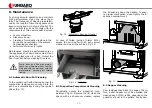
7
INSTALLATION AND OPERATION MANUAL
Outdoor Chimney (fig. 6)
Inspection
Insulated
Outdoor
Section
Inspection
Insulated
Outdoor
Section
fig. 6 - Outdoor Chimney
Non-condensing insulated chimney system
must be used for external applications. A
chimney tee comprising a cap should be
placed at the bottom of the vertical section
of the chimney.
Existing flue (fig. 7)
Chimney
Cowl
Chimney
Inspection
Chimney
Inspection
Chimney
Cowl
fig. 7 - Existing Flue
At the base of the flue is advisable to install
a hermitically sealed cleanout access for
collecting ash and condensate, in a position
where it can be periodically inspected.
The first section should not be a
90° bend, as ash would block the
discharge of flue gasses in a short
time, causing draught problems.
3.6 Air intake
For proper functioning, the appliance should
be positioned in a location where it is able
to take in the air necessary for combustion.
Provide an air intake hole Ø100 mm² clo-
se to the stove. Protect it with a grill grate
from inside and outside (fig. 8).
Large mesh grill
Free Hole
fig. 8 - Air Intake
If there are no perimeter walls in the
installation room, the hole should connect
the installation room to an adjacent room
from which continue the chain until you
reach an outside wall.
Unless the installation involves a sealed
chamber product, there is no obligation to
take the combustion air from the outside
of the house through a pipe connected
directly to the generator. If this type of
installation is deemed necessary, the direct
intake of the combustion air must be carried
out through the wall immediately behind
the generator, using only straight ducts of
suitable material with the section not less
than the air inlet diameter of the generator.
The air intake pipe placed outside must be
equipped with a grill grate preventing the








































